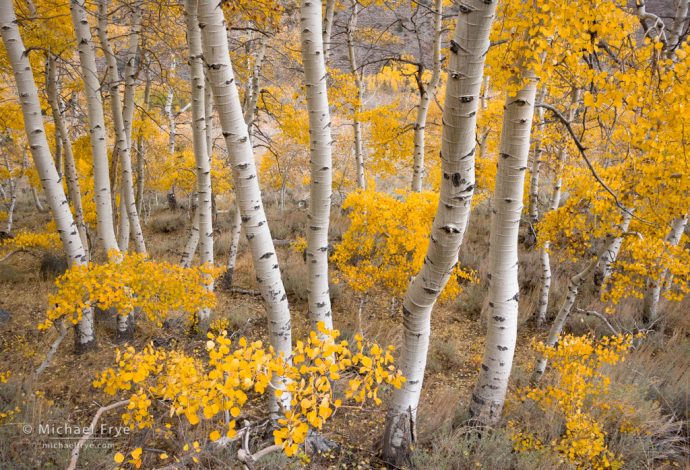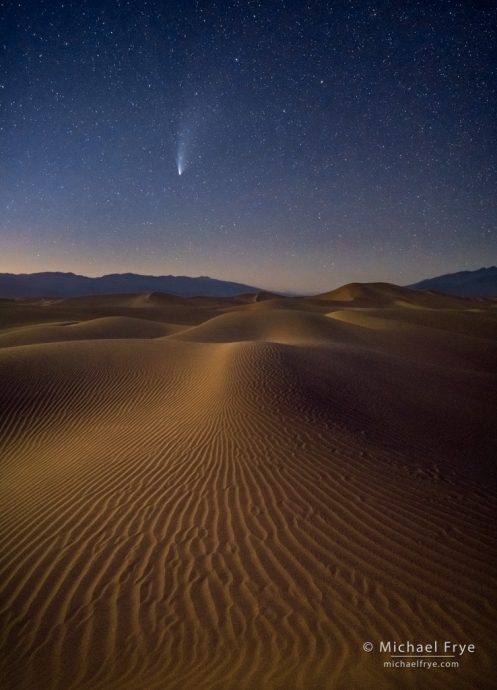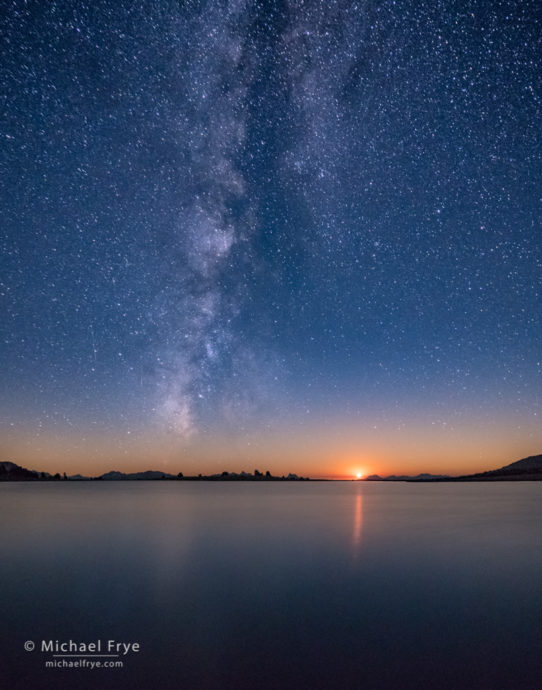In the Moment:
Michael Frye's Landscape Photography Blog
by Michael Frye | Nov 5, 2017 | Advanced Techniques

Late-October aspens near Silver Lake, June Lake Loop, Inyo NF, CA, USA. I used f/16 to get everything in focus in this 2008 photograph from the eastern Sierra. (The shutter speed was 1/6th second, the ISO 400.)
I sometimes post my camera settings here on the blog, and I’ve had many people ask me why I often use f/16. Is that the sharpest aperture on my lens? (No.) Don’t you get diffraction at f/16? (A little bit.) Is it for depth of field? (Bingo!)
As many of you know, most lenses are sharpest at middle apertures – generally around f/5.6 to f/11, depending on the lens.
Better lenses will perform decently at wide apertures like f/2.8 or f/4, but usually the corners are softer compared to the middle apertures. On the other end of the spectrum, at smaller apertures diffraction causes all lenses to get softer over the entire image (not just the corners).
(more…)
by Michael Frye | Jan 4, 2017 | Announcements
The votes are all in and counted, and here are my top photographs of 2016!
We had an amazing response this year: a record-breaking 728 people looked through my initial selection of 47 images and voted for their favorites here on the blog, on Facebook, and through email. A big thank you to everyone who took the time to look through these photographs and voice your opinions! I also really appreciate all the kind words expressed along with the votes. I wish I could respond to every comment and email, but please know that I’ve read them all and am very grateful for all your support. And also, many thanks to my wonderful assistant Claudia who tallied all those votes!
To express our gratitude to all the voters we’ve decided to give away two prints this year. We assigned each person who voted a number, and used a random number generator to pick the recipients. And the winners are… Fred Littooy and Geoffrey Robinson! Fred and Geoff will each receive a signed and numbered 16×20 print of their choice from among the 47 original selections. Congratulations Fred and Geoff!
This year I thought the top twelve vote-getters made a more well-rounded selection than the top ten, so I expanded the final selection to include a dozen images. Here’s the list of the twelve images that received the most picks, and the number of votes they each received:
(more…)
by Michael Frye | Dec 31, 2016 | Announcements
I’ve closed comments on this post, since the voting deadline has passed. You can see the final selections here. Thanks to all of you who voted!
Happy New Year!
Like champagne, Auld Land Syne, and the Tournament of Roses Parade, it’s become a New Year’s tradition on this blog to pick my best images from the past year, and once again I’m inviting you to help me make these difficult choices. I’ve posted 47 of my best photographs from 2016 below, in chronological order. After you look through these, please post a comment listing your ten favorites.
You don’t have to list your ten favorites in any order, or even name them – just numbers will do. (The numbers are in the captions underneath the photographs. Also, you can click on the images to see them larger.) Once the votes are in I’ll post the top ten on this blog, and submit the final group to Jim Goldstein’s blog project, where he’ll be showcasing the best images of the year from over 300 photographers. The voting deadline is this Tuesday, January 3rd, at midnight Pacific time.
(more…)
by Michael Frye | Aug 2, 2020 | Night Photography, Travels and Stories

Comet NEOWISE over moonlit sand dunes, Death Valley. 20mm, 16 frames blended to reduce noise, each frame 15 seconds at f/2.4, ISO 6400.
I knew it would be hot. It was July, after all, and Death Valley is perhaps the hottest place on earth. But I was actually lucky; summer temperatures in Death Valley often climb above 120 degrees Fahrenheit, while the high temp on the day I was there was only 113. Practically a cold snap.
What was I doing in Death Valley in July? Photographing Comet NEOWISE of course. I know the internet has been flooded by comet images lately, but I totally get it. The last really photogenic comet visible in the northern hemisphere was Hale-Bopp in 1997. Who knows when we’ll see another one?
(more…)
by Michael Frye | Aug 16, 2016 | Night Photography

Moon setting over an alpine lake, Yosemite, 1:00 a.m. Friday morning
After our trip to the Alabama Hills Claudia and I drove back up to Yosemite, and on Thursday night we hiked up to an alpine lake to view the peak of the Perseid meteor shower. Knowing that the moon wouldn’t set until nearly 1:00 a.m., we didn’t start hiking until well after dark, and arrived at the lake around 12:30 a.m.
The moon setting over the lake was a beautiful sight. As the moon sank lower it turned orange, just like the setting sun. It also became dimmer, so the stars came out. The extreme contrast made photographing this scene difficult, but when the moon reached a point right above the horizon the contrast dropped just enough, and I was able to capture the image above. In many ways this looks just like a sunset photograph – except for the sky full of stars.
(more…)











